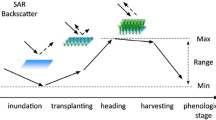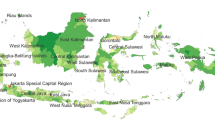Abstract
There are many illegal land use sites in develo** countries that are experiencing a process of rapid urbanization. Short-interval, such as monthly, land use and land cover (LULC) change information is important for detecting and preventing illegal land development at its early stage. Conventional optical remote sensing is limited by weather conditions and has great limitation in collecting images in regions characterized by frequent cloud cover. Radar remote sensing, not affected by clouds, is therefore an effective tool for collecting timely LULC information in these regions. Polarimetric synthetic aperture radar (PolSAR) is a currently advanced radar remote sensing technique. This study explores the potential of PolSAR data in short-interval monitoring of LULC change by using RADARSAT-2 PolSAR images. Monthly LULC changes were extracted from a time series of RADARSAT-2 images by using change vector analysis and post-classification comparison based on object-oriented image analysis. The average detection accuracy, average false alarm rate, and average overall error rate for change detection were 91.29 %, 1.37 %, and 1.97 % respectively. The average overall accuracy and average kappa value for determining types of changes were 72.44 % and 0.68 respectively. The results indicate that it is effective in using a time series of RADARSAT-2 PolSAR images in short-interval monitoring of LULC change, especially in monitoring potential illegal land development.
Access this chapter
Tax calculation will be finalised at checkout
Purchases are for personal use only
Similar content being viewed by others
References
Baatz, M., Benz, U., Dehghani, S., Heynen, M., Höltje, A., Hofmann, P., et al. (2004). eCognition professional user guide 4. Munich: Definiens Imaging.
Barnes, C. F., & Burki, J. (2006). Late-season rural land-cover estimation with polarimetric-SAR intensity pixel blocks and sigma-tree-structured near-neighbor classifiers. IEEE Transactions on Geoscience and Remote Sensing, 44(9), 2384–2392.
Benz, U. C., Hofmann, P., Willhauck, G., Lingenfelder, I., & Heynen, M. (2004). Multi-resolution, object-oriented fuzzy analysis of remote sensing data for GIS-ready information. ISPRS Journal of Photogrammetry and Remote Sensing, 58(3), 239–258.
Bovolo, F., & Bruzzone, L. (2007). A theoretical framework for unsupervised change detection based on change vector analysis in the polar domain. IEEE Transactions on Geoscience and Remote Sensing, 45(6), 218–236.
Camps-Valls, G., Gomez-Chova, L., Munoz-Mari, J., Rojo-Alvarez, J. L., & Martinez-Ramon, M. (2008). Kernel-based framework for multitemporal and multisource remote sensing data classification and change detection. IEEE Transactions on Geoscience and Remote Sensing, 46(6), 1822–1835.
Chen, K. S., Huang, W. P., Tsay, D. H., & Amar, F. (1996). Classification of multifrequency polarimetric SAR imagery using a dynamic learning neural network. IEEE Transactions on Geoscience and Remote Sensing, 34(3), 814–820.
Collins, J. B., & Woodcock, C. E. (1996). An assessment of several linear change detection techniques for map** forest mortality using multitemporal Landsat TM data. Remote Sensing of Environment, 56(1), 66–77.
Congalton, R., & Green, K. (2009). Assessing the accuracy of remotely sensed data: Principles and practices. Boca Raton: CRC Press.
Coppin, P. R., & Bauer, M. E. (1994). Processing of multitemporal Landsat TM imagery to optimize extraction of forest cover change features. IEEE Transactions on Geoscience and Remote Sensing, 32(4), 918–927.
Coppin, P., Jonckheere, I., Nackaerts, K., Muys, B., & Lambin, E. (2004). Digital change detection methods in ecosystem monitoring: A review. International Journal of Remote Sensing, 25(9), 1565–1596.
Du, L., & Lee, J. S. (1996). Fuzzy classification of earth terrain covers using complex polarimetric SAR data. International Journal of Remote Sensing, 17(4), 809–826.
Foody, G. M. (2001). Monitoring the magnitude of land-cover change around the southern limits of the Sahara. Photogrammetric Engineering and Remote Sensing, 67(7), 841–847.
Forster, M., Frick, A., Walentowski, H., & Kleinschmit, B. (2008). Approaches to utilising QuickBird data for the monitoring of NATURA 2000 habitats. Community Ecology, 9(2), 155–168.
Freitas, C. D., Soler, L. D., Anna, S. J. S. S., Dutra, L. V., dos Santos, J. R., Mura, J. C., & Correia, A. H. (2008). Land use and land cover map** in the Brazilian Amazon using polarimetric airborne p-band SAR data. IEEE Transactions on Geoscience and Remote Sensing, 46(10), 2956–2970.
Fung, T. (1990). An assessment of TM imagery for land-cover change detection. IEEE Transactions on Geoscience and Remote Sensing, 28(4), 681–684.
Gao, Y., Mas, J. F., Maathuis, B. H. P., Zhang, X. M., & Van Dijk, P. M. (2006). Comparison of pixel-based and object-oriented image classification approaches – A case study in a coal fire area, Wuda, Inner Mongolia, China. International Journal of Remote Sensing, 27(18), 4039–4055.
Howarth, P. J., & Boasson, E. (1983). Landsat digital enhancements for change detection in urban environments. Remote Sensing of Environment, 13(2), 149–160.
Howarth, P. J., & Wickware, G. M. (1981). Procedures for change detection using Landsat digital data. International Journal of Remote Sensing, 2(3), 277–291.
Jensen, J. R., & Toll, D. L. (1982). Detecting residential land-use development at the urban fringe. Photogrammetric Engineering and Remote Sensing, 48(4), 629–643.
Lambin, E. F., & Strahler, A. H. (1994). Change-vector analysis in multitemporal space – A tool to detect and categorize land-cover change processes using high temporal-resolution satellite data. Remote Sensing of Environment, 48(2), 231–244.
Lee, J. S., Grunes, M. R., Ainsworth, T. L., Du, L. J., Schuler, D. L., & Cloude, S. R. (1999). Unsupervised classification using polarimetric decomposition and the complex Wishart classifier. IEEE Transactions on Geoscience and Remote Sensing, 37(5), 2249–2258.
Lee, J. S., Grunes, M. R., & Pottier, E. (2001). Quantitative comparison of classification capability: Fully polarimetric versus dual and single-polarization SAR. IEEE Transactions on Geoscience and Remote Sensing, 39(11), 2343–2351.
Lee, J. S., Wen, J. H., Ainsworth, T. L., Chen, K. S., & Chen, A. J. (2009). Improved sigma filter for speckle filtering of SAR imagery. IEEE Transactions on Geoscience and Remote Sensing, 47(1), 202–213.
Li, X., & Yeh, A. G. O. (1998). Principal component analysis of stacked multi-temporal images for the monitoring of rapid urban expansion in the Pearl River Delta. International Journal of Remote Sensing, 19(8), 1501–1518.
Li, X., & Yeh, A. G. (2004). Multitemporal SAR images for monitoring cultivation systems using case-based reasoning. Remote Sensing of Environment, 90(4), 524–534.
Li, X., Yeh, A. G. O., Qian, J. P., Ai, B., & Qi, Z. X. (2009). A matching algorithm for detecting land use changes using case-based reasoning. Photogrammetric Engineering and Remote Sensing, 75(11), 1319–1332.
López-Martínez, C., Ferro-Famil, L., & Pottier, E. (2005). PolSARpro v4.0 polarimetry tutorial. Paris: European Space Agency. http://earth.esa.int/polsarpro/tutorial.html
Lu, D., Mausel, P., Brondizio, E., & Moran, E. (2004). Change detection techniques. International Journal of Remote Sensing, 25(12), 2365–2407.
Lupo, F., Reginster, I., & Lambin, E. F. (2001). Monitoring land-cover changes in West Africa with SPOT vegetation: Impact of natural disasters in 1998–1999. International Journal of Remote Sensing, 22(13), 2633–2639.
Malila, W. A. (1980). Change vector analysis: An approach for detecting forest changes with Landsat. In Proceedings of the 6th annual symposium on machine processing of remotely sensed data (pp. 326–336). Purdue University, West Lafayette, IN, USA.
McCoy, R. M. (2005). Field methods in remote sensing. New York: The Guilford Press.
Moon, T. K. (1996). The expectation-maximization algorithm. IEEE Signal Processing Magazine, 13(6), 47–60.
PaxLenney, M., & Woodcock, C. E. (1997). The effect of spatial resolution on the ability on to monitor the status of agricultural lands. Remote Sensing of Environment, 61(2), 210–220.
Petit, C. C., & Lambin, E. F. (2001). Integration of multi-source remote sensing data for land cover change detection. International Journal of Geographical Information Science, 15(8), 785–803.
Pierce, L. E., Ulaby, F. T., Sarabandi, K., & Dobson, M. C. (1994). Knowledge-based classification of polarimetric SAR images. IEEE Transactions on Geoscience and Remote Sensing, 32(5), 1081–1086.
Pierce, L. E., Bergen, K. M., Dobson, M. C., & Ulaby, F. T. (1998). Multitemporal land-cover classification using SIR-C/X-SAR imagery. Remote Sensing of Environment, 64(1), 20–33.
Qi, Z., Yeh, A. G.-O., Li, X., & Lin, Z. (2012). A novel algorithm for land use and land cover classification using RADARSAT-2 polarimetric SAR data. Remote Sensing of Environment, 118, 21–39.
Qi, Z., & Yeh, A. G. O. (2013). Integrating change vector analysis, post-classification comparison, and object-oriented image analysis for land use and land cover change detection using RADARSAT-2 polarimetric SAR images. In S. Timpf & P. Laube (Eds.), Advances in spatial data handling (pp. 107–123). Berlin: Springer.
Quarmby, N. A., & Cushnie, J. L. (1989). Monitoring urban land cover changes at the urban fringe from spot Hrv imagery in southeast England. International Journal of Remote Sensing, 10(6), 953–963.
Saatchi, S. S., Soares, J. V., & Alves, D. S. (1997). Map** deforestation and land use in Amazon rainforest by using SIR-C imagery. Remote Sensing of Environment, 59(2), 191–202.
Seto, K. C., Woodcock, C. E., Song, C., Huang, X., Lu, J., & Kaufmann, R. K. (2002). Monitoring land-use change in the Pearl River Delta using Landsat TM. International Journal of Remote Sensing, 23(10), 1985–2004.
Shen, G., Guo, H., & Liao, J. (2007). Change vector analysis method for inundation change detection using multi-temporal multi-polarized SAR images. In Proceedings of SPIE, Wuhan, China.
Shimoni, M., Borghys, D., Heremans, R., Perneel, C., & Acheroy, M. (2009). Fusion of PolSAR and PolInSAR data for land cover classification. International Journal of Applied Earth Observations and Geoinformation, 11(3), 169–180.
Silapaswan, C. S., Verbyla, D. L., & McGuire, A. D. (2001). Land cover change on the Seward Peninsula: The use of remote sensing to evaluate the potential influences of climate warming on historical vegetation dynamics. Canadian Journal of Remote Sensing, 27(5), 542–554.
Singh, A. (1989). Digital change detection techniques using remotely-sensed data. International Journal of Remote Sensing, 10(6), 989–1003.
Sonmez, N. K., Onur, I., Sari, M., & Maktav, D. (2009). Monitoring changes in land cover/use by CORINE methodology using aerial photographs and IKONOS satellite images: A case study for Kemer, Antalya, Turkey. International Journal of Remote Sensing, 30(7), 1771–1778.
Stefanov, W. L., Ramsey, M. S., & Christensen, P. R. (2001). Monitoring urban land cover change: An expert system approach to land cover classification of semiarid to arid urban centers. Remote Sensing of Environment, 77(2), 173–185.
Story, M., & Congalton, R. G. (1986). Accuracy assessment – A user’s perspective. Photogrammetric Engineering and Remote Sensing, 52(3), 397–399.
Ulaby, F. T., Kouyate, F., Brisco, B., & Williams, T. H. L. (1986). Textural information in SAR images. IEEE Transactions on Geoscience and Remote Sensing, 24(2), 235–245.
Weismiller, R. A., Kristof, S. J., Scholz, D. K., Anuta, P. E., & Momin, S. A. (1977). Change detection in coastal zone environments. Photogrammetric Engineering and Remote Sensing, 43(12), 1533–1539.
Wilson, E. H., & Sader, S. A. (2002). Detection of forest harvest type using multiple dates of Landsat TM imagery. Remote Sensing of Environment, 80(3), 385–396.
Witten, I. H., Frank, E., & Hall, M. A. (2011). Data mining: Practical machine learning tools and techniques. Burlington: Morgan Kaufmann.
Yeh, A. G. O., & Li, X. (1996). Urban growth management in the Pearl River Delta – An integrated remote sensing and GIS approach. ITC Journal, 1, 77–86.
Author information
Authors and Affiliations
Corresponding author
Editor information
Editors and Affiliations
Rights and permissions
Copyright information
© 2015 Springer Science+Business Media Dordrecht.
About this chapter
Cite this chapter
Yeh, A.GO., Qi, Z. (2015). Short-Interval Monitoring of Land Use and Land Cover Change Using a Time Series of RADARSAT-2 Polarimetric SAR Images. In: Kwan, MP., Richardson, D., Wang, D., Zhou, C. (eds) Space-Time Integration in Geography and GIScience. Springer, Dordrecht. https://doi.org/10.1007/978-94-017-9205-9_19
Download citation
DOI: https://doi.org/10.1007/978-94-017-9205-9_19
Published:
Publisher Name: Springer, Dordrecht
Print ISBN: 978-94-017-9204-2
Online ISBN: 978-94-017-9205-9
eBook Packages: Earth and Environmental ScienceEarth and Environmental Science (R0)




